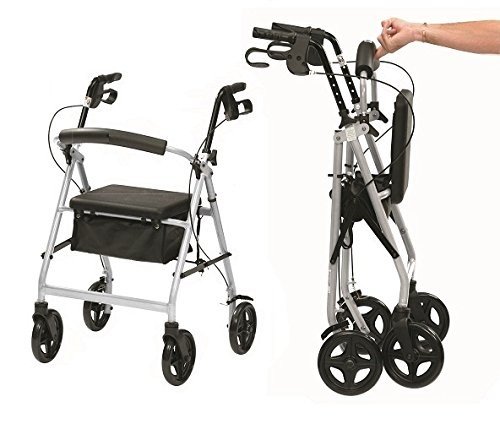LeesJorge
LeesJorge发表的博客

The Benefits and Features of Walkers with Seats: A Comprehensive Guide
Mobility is a critical component of preserving independence as people age or recuperate from injuries. Amongst the different mobility aids offered, walkers have ended up being significantly popular for their versatility and support. One particular type is the walker with a seat, which provides both help in walking and a resting location when required. This article explores the features, benefits, and factors to consider of walkers with seats, ultimately assisting potential users in selecting the best mobility aid.
What Is a Walker with Seat?
A walker with a seat is a mobility aid designed for individuals who may require assistance while walking however also need the option to rest regularly. These walkers generally feature four legs, sturdy deals with for grip, and a built-in seat that enables the user to take breaks as essential. The design of these devices varies, offering choices that cater to various preferences and requirements.
Secret Features of Walkers with Seats
When thinking about a walker with a seat, a number of essential features need to be considered:
- Sturdy Construction: Most walkers are constructed from durable materials such as aluminum or steel to make sure support and safety.
- Adjustable Height: Many designs come with adjustable handles to accommodate users of different heights, making sure correct posture and convenience.
- Lightweight Design: For easier maneuverability, lots of walkers with seats are designed to be lightweight yet stable.
- Safety Features: Some come geared up with features such as non-slip grips, locking brakes, and reflective strips for presence and safety.
- Storage Options: Walkers may include baskets or trays for carrying personal products, which can improve benefit during use.
Benefits of Using a Walker with Seat
The many benefits of a walker with a seat make it an exceptional choice for many people:
Enhanced Mobility: A walker with a seat permits users to preserve mobility while providing the essential support to avoid falls.
Convenient Resting Option: The integrated seat allows users to rest whenever they feel fatigued, promoting overall endurance and comfort.
Improved Confidence: Individuals often gain more confidence in their mobility when utilizing a walker that supports them, resulting in greater independence.
Posture Support: A properly designed walker encourages users to maintain much better posture while walking, which can assist in lowering back and joint pressure.
Social Interaction: A walker with a seat can encourage users to take part in social settings, as they can comfortably take breaks during activities.
Choosing the Right Walker with Seat
Selecting the appropriate walker with a seat involves thinking about different elements to ensure it fulfills the user's needs. Here's a list to help in choosing the best walker with seat:
Considerations for Selection
User's Physical Condition: Assess the physical abilities and constraints of the user. Are they able to handle their weight with the walker? Do they require more stability?
Weight Capacity: Ensure that the walker can support the user's weight comfortably. The majority of walkers have particular weight limits.
Mobility: For those who prepare to travel or move frequently, consider the weight and foldability of the walker.
User Preferences: Users may have specific choices regarding style, color, or extra functions that accommodate their way of life.
Spending plan: Walkers with seats can differ in price based on products and features. It's essential to choose one that satisfies the required requirements without surpassing the budget.
Table: Comparison of Popular Walker with Seat Models
| Walker Model | Weight Capacity | Seat Height | Adjustable Handles | Price Range | Bonus Features |
|---|---|---|---|---|---|
| Rollator Walker 1 | 300 lbs | 22 inches | Yes | ₤ 100 - ₤ 150 | Basket, folding style |
| Rollator Walker 2 | 250 lbs | 21 inches | Yes | ₤ 80 - ₤ 120 | Cushioned seat, adjustable back-rest |
| Rollator Walker 3 | 350 lbs | 23 inches | Yes | ₤ 150 - ₤ 200 | Locking brakes, rear wheels |
| Foldable Walker 1 | 300 pounds | 20 inches | Yes | ₤ 70 - ₤ 110 | Lightweight, simple storage |
Frequently Asked Questions (FAQs)
1. Can people use walkers with seats if they have limited upper body strength?
Yes, walkers with seats are developed to provide assistance and stability for individuals with various strength levels. Selecting a model with sturdy handgrips and brakes can boost safety.
2. Are walkers with seats appropriate for outdoor use?
Absolutely. Many walkers with seats are developed for both indoor and outdoor use. Nevertheless, it is recommended to choose designs with bigger wheels for much better maneuverability on outdoor surfaces.
3. How do I keep a walker with a seat?
Regularly check the rubber pointers for wear, make sure that all moving parts are operating properly, and clean the walker to avoid dirt accumulation. If any parts are harmed, replace them promptly.
4. How can I improve my walking ability while using a walker with a seat?
Regular physical therapy and balance workouts can assist enhance strength and coordination, assisting in better mobility even when using a walker.
5. Is it possible to change the height of walkers with seats?
A lot of modern walkers with seats include adjustable heights for the handles to accommodate different user heights, making sure convenience and correct posture.
Walkers with seats use vital benefits for people looking for increased mobility and convenience. By understanding the functions, benefits, and important selection requirements, users and caregivers can make educated choices concerning mobility aids. With the right walker, users can enjoy improved self-reliance and improved lifestyle.

